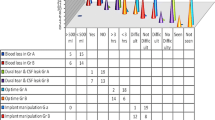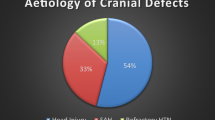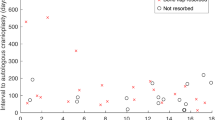Abstract
Introduction
Replacement sources for calvarial defects include synthetic materials, donor grafts, and autologous bones such as ribs or split-thickness calvarial cranioplasty. When these sources are not available or are inadequate, other structures or sites would be desirable. However, and to our knowledge, the scapula has not been explored as a potential source for calvarial reconstruction. Therefore, the following study was performed to verify the utility of this bone for cranioplasty.
Materials and Methods
Six adult (mean age 71 years) cadavers (four formalin-fixed and two fresh specimens) were used in this study. In the prone position, an incision was made over the midpart of the infraspinous fossa. Soft tissues were then removed from the anterior and posterior aspects of the scapula in this region avoiding the glenohumeral articulation superiorly. Previously made cranial defects were then filled using available scapula as a bony replacement.
Results
An average of 9 × 12 × 7 cm of scapula was available for harvest inferior to the glenohumeral joint. Lateral and medial borders of the scapula were found to have a mean thickness of 9 mm. No obvious injury to surrounding vessels or nerves was found using this procedure and good coverage of calvarial defects was afforded by this bony replacement.
Conclusions
Such a bony substitute as autologous scapula might be of utility when other replacements are not available or are of a limited size. Examples of such a use would include patients in whom a hemispheric bone flap is lost. Following clinical confirmation, the neurosurgeon may wish to consider the scapula as an alternative site for bone harvest for cranioplasty as this was a feasible technique in the cadaver.









Similar content being viewed by others
References
Ang E, Black C, Irish J, Brown DH, Gullane P, O, Sullivan B, Neligan PC (2003) Reconstructive options in the treatment of osteoradionecrosis of the craniomaxillofacial skeleton. Brit J Plastic Surg 56:92–99
Bast P, Engelhardt M, Lauer w, Schmieder K, Rohde V, Radermacher K (2003) Identification of milling parameters for manual cutting of bicortical bone structures. Comput Aided Surg 8:257–263
Fujisawa K, Hirata H, Inada H, Morita A, Takeda K, Hibasami H (1995) Value of dynamic MR scan in predicting vascular ingrowth from free vascularized scapular transplant used for treatment of avascular femoral head necrosis. Microsurgery 16:673–678
Hoffman HT, Harrison N, Sullivan MJ, Robbins T, Ridley M, Baker SR (1991) Mandible reconstruction with vascularized bone grafts. Arch Otolaryngol Head Neck Surg 117:917–925
Martin D, Pistre V, Pinsolle V, Pelissier P, Baudet J (2000) The scapula: a preferred donor site for a free flaps or pedicle transfers. Ann Chir Plast Esthet 45:272–283
Pistner H, Reuther JF, Bill J, Michel C, Reinhart E (1994) Microsurgical scapula transplants for reconstruction of the facial skull—experiences with 44 patients. Fortschr Kiefer Gesichtschir 39:122–126
Robertson GA (1986) The role of sternum in osteomyocutaneous reconstruction of major mandibular defects. Am J Surg 152:367–370
Schlenz I, Korak KJJ, Kunsfeld R, Vinzenz K, Plenk H, Holle J (2001) The dermis-prelaminated scapula flap for reconstructions of the hard palate and the alveolar ridge: a clinical and histologic evaluation. Plast Reconstructive Surg 108:1519–1524
Schliephake H (2000) Revascularized tissue transfer for the repair of complex midfacial defects in oncologic patients. J Oral Maxillofac Surg 58:1212–1218
Sullivan MJ, Carroll WR, Baker SR, Crompton R, Smith-Wheelock M (1990) The free scapular flap for head and neck reconstruction. Am J Otolaryngol 11:318–327
Sundine MJ, Sharbobaro VI, Liubic I, Acland RD, Tobin GR (2000) Inferior angle of the scapula as a vascularized bone graft: an anatomic study. J Reconstr Microsurg 16:207–211
Takushima A, Harii K, Asato H, Momosawa A, Okazaki M, Nakatsuka T (2005) Choice of osseous and osteocutaneous flaps for mandibular reconstruction. Int J Clin Oncol 10:234–242
Tang YB, Hahn LJ (1990) Major mandibular reconstruction with vascularized bone graft. J Formos Med Assoc 89:34–40
Teot L, Bosse JP, Moufarrege R, Papillin J, Beauregard G (1981) The scapular crest pedicled bone graft. Int J Microsurg 3:257–262
Thoma A, Archibald S, Payk I, Young JEM (1991) The free medial scapular osteofasciocutaneous flap for head and neck reconstruction. Brit J Plast Surg 44:477–482
Yamada A, Harii K, Ueda K, Nakatsuka T, Asato H, Kajikawa A (1996) Secondary contour reconstruction of maxillectomy defects with a bone graft vascularized by flowthrough from radial vascular system. Microsurgery 17:141–145
Author information
Authors and Affiliations
Corresponding author
Rights and permissions
About this article
Cite this article
Tubbs, R.S., Loukas, M., Shoja, M.M. et al. Use of autologous scapula for cranioplasty: cadaveric feasibility study. Childs Nerv Syst 24, 955–959 (2008). https://doi.org/10.1007/s00381-008-0592-x
Received:
Published:
Issue Date:
DOI: https://doi.org/10.1007/s00381-008-0592-x




